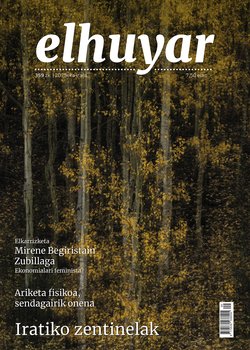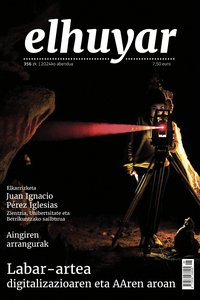Climbing material with the Pou brothers
ENEKO POU; climber: Hello there, Nagore!
NAGORE REMENTERIA; Elhuyar Foundation: Iker and Eneko Pou! How's it going, okay?
IKER POU; climber:Oh, yeah, yeah.
NAGORE REMENTERIA; Elhuyar Foundation:It’s not easy to get them at home, is it?
IKER POU; climber: Hard, hard, hard. We are always outside, climbing around Vitoria or... always outside.
NAGORE REMENTERIA; Elhuyar Foundation:This time we're lucky that you're both here.
ENEKO POU; climber: Oh, yeah, yeah. We stopped at Murguía, barely fifteen minutes from Vitoria-Gasteiz, about 20 km away. It is a place that we like a lot, mostly because of the landscape. It is a good climbing school, but it is not the best in the Basque Country. But the place is worth it.
NAGORE REMENTERIA; Elhuyar Foundation: The backpack? With the material?
ENEKO POU; climber:You asked for a lot of material
NAGORE REMENTERIA; Elhuyar Foundation: Yes, to show you what you use to climb. Well, here we go!
ENEKO POU; climber:Did the little gift have weight?
NAGORE REMENTERIA; Elhuyar Foundation: Not the big one. The lighter, the better, right? How many pounds of material do you normally carry? Have you measured it?
IKER POU; climber: No, I don't. Depending on the wall we are going to climb, we carry one or the other material. Since it's a sports climb here, it doesn't weigh that many backpacks. Ten kilos maximum, all included.
ENEKO POU; climber: Yeah, but you made it up. What we are looking for is always agility. Then we use the best materials and the lightest ones.
NAGORE REMENTERIA; Elhuyar Foundation: To climb this wall, for example, what materials will you use?
ENEKO POU; climber: Little material to climb this wall. You'll see it now.
IKER POU; climber: They're usually secure, so we take the express. You put them in these safes, as you climb the rope passes through these safes, so if you fall, you stay suspended.
ENEKO POU; climber:Look, it's all very light.
NAGORE REMENTERIA; Elhuyar Foundation:Yeah, aluminum or something.
ENEKO POU; climber: Many years ago there were big problems: they were going to make huge walls, like in 1900, and each carabiner weighed what this whole lot weighs.
It hangs from here to the rock security, and the rope passes through here. The bottom carabiner is curved, and what it does is help to insert the rope. Besides this, this is a new harness, Nagore. Very light. Very light. The old ones were much bigger, less resistant, less light. And these are light and have a lot of resistance.
We will continue to see things. This is more or less a high mountain material, a material used on large walls.
It originates in the revolution of sports climbing, around 1975. They were first used in the Yosemite Valley in the United States. The current ones are much larger, with a lot of resistance. They get into the cracks.
This is where we see the rope.
NAGORE REMENTERIA; Elhuyar Foundation: Are there different types of strings?
ENEKO POU; climber: Yes, of many kinds. In this case, this is dynamic. What we climbers use is always dynamic, because we need to have flexibility when falling so as not to hurt ourselves, mostly in the back.
This is a modern cat's foot, a climbing shoe. Perhaps the most important thing is the gum it contains. It was discovered approximately in 1975. it's called "Cocido Gum." And to give you an idea, it’s similar to the wheels they use in Formula 1. If you have to climb, something very technical, very difficult, you wear a number two to three smaller than the shoe, very tight. The idea is to carry your foot in this way, in tension, so that you can place it in very small places, that's why they also have such a point. It's very elaborate.
IKER POU; climber: We're putting them safe with this. The safe ones you see on the wall, the chemicals or the parabolts, we have to go in with something, and the easiest thing, in sports climbing, is to go in with a drill. This is a battery drill, it doesn't weigh much, three kilos or so. With this we make holes, and then we have to introduce material like this. We see them here... this is a meeting place. In sports climbing we have them at the meeting point to go down: we go climbing and we include the safe ones, but then we have to remove them. So when we get to the top or the top of the road, there’s a descent like this, and what we do is we pass the rope through here, you get stuck in the pulley, and then we remove all the material from below.
ENEKO POU; climber: Iker is tied to the harness with the rope, he starts climbing with the rope, and I have placed this device; it is called GriGri. What it does is block it. The system is similar to the safety belt we use in cars. If the climber falls, it's blocked, and if it's given off...
NAGORE REMENTERIA; Elhuyar Foundation:So, do you have to hold it with your body?
ENEKO POU; climber: More or less, yes, but he just blocks himself. So, if you’re a little clueless, that should never happen, just lock up, and the climber hangs.
It was also a very good invention at the time, approximately in 1991; this is more recent.
NAGORE REMENTERIA; Elhuyar Foundation: So, the work of what's down here is important. It’s not just about taking the rope and climbing, the one below also needs to be attentive.
ENEKO POU; climber: Whoever's down there must be looking at the climber. He can't talk to his neighbor.
NAGORE REMENTERIA; Elhuyar Foundation: For example, now.
ENEKO POU; climber: If he wants to pass the rope and you don't give it to him, he can fall. He's asking me for the rope, very fast...
NAGORE REMENTERIA; Elhuyar Foundation:Give me the rope!
ENEKO POU; climber: The present invention is very new, it will only be four years old, five years at most.
NAGORE REMENTERIA; Elhuyar Foundation: I'm sure the optics had already been invented.
ENEKO POU; climber: I'm sure they will. It's a normal prism at the end; it has nothing else.
NAGORE REMENTERIA; Elhuyar Foundation:But now it has a new application, right?
ENEKO POU; climber: A new application for climbing. They're not very aesthetic. It makes the climber look great. I'm very attentive to Iker without putting my neck back. I think it was a beautiful invention. And if you consider how I have a neck, a wonderful invention!
ENEKO POU; climber: A long and beautiful!
NAGORE REMENTERIA; Elhuyar Foundation:Are you training then?
IKER POU; climber: Yes, a little more!
ENEKO POU; climber:The weather is beautiful and it’s a wonderful afternoon to climb.
NAGORE REMENTERIA; Elhuyar Foundation: Well, I'll go. Go on well and have good luck. Say good-bye to him!
ENEKO POU; climber:Say good-bye to him!
IKER POU; climber: Say good-bye to him!
Buletina
Bidali zure helbide elektronikoa eta jaso asteroko buletina zure sarrera-ontzian











